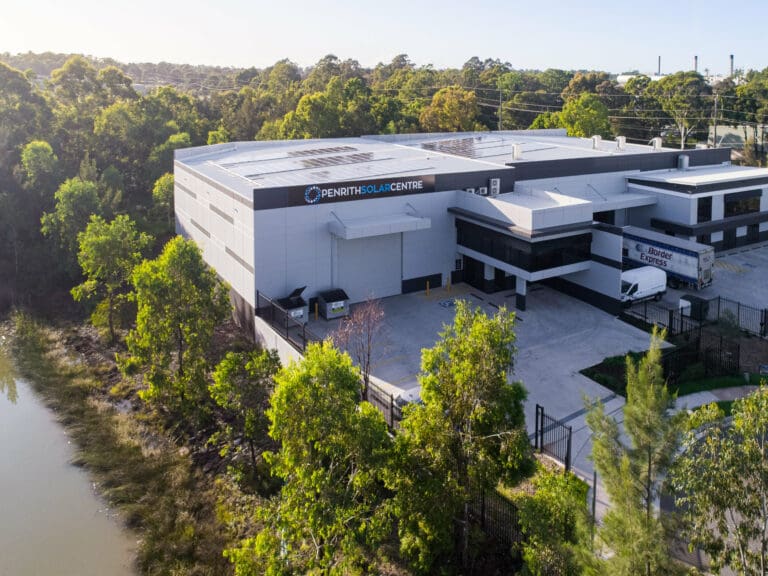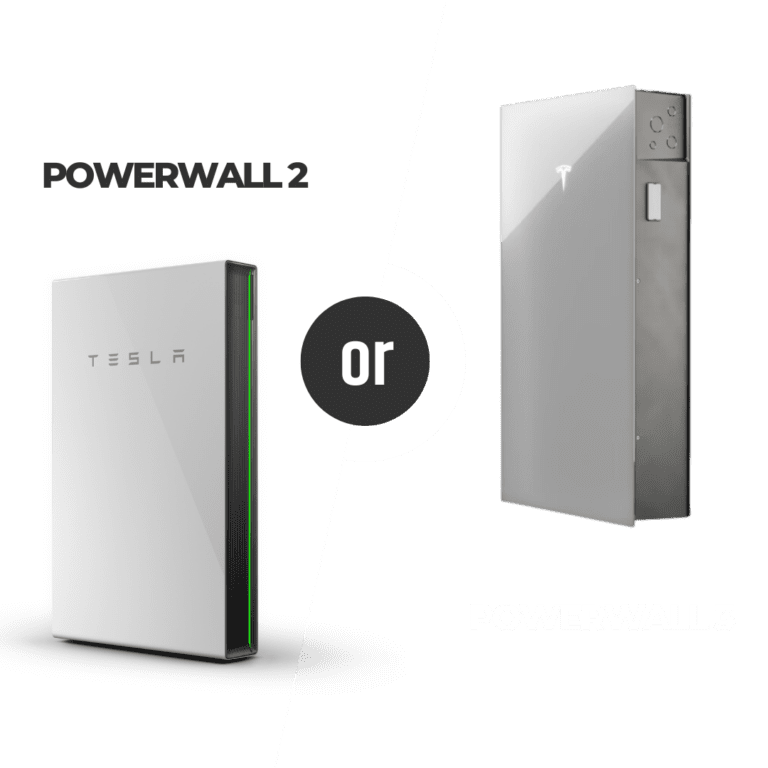As you explore solar power options for your home, you’ve come across a lot of terms and information. We understand how overwhelming it can be. There’s so much technical language. “Inverter” is one of those terms.
You’re here for solar panels. Why should you care about something called an “inverter?”
An inverter is a piece of equipment in your solar system that converts direct current (DC) electricity into alternating current (AC) electricity. And what do you get when AC and DC run into each other? Well, you get a most excellent rock band – the pride of Sydney.
All jokes aside, you will need to decide between a microinverter solar system or a string inverter solar system when it comes to choosing the right equipment for your energy needs.
Inverters are so much more important to your savings than the solar panels. Inverters are the heart and soul of your solar setup. They are the bridge between your solar panels and your home’s electrical system.
Deciding on which type of solar system to invest in is a big decision that will inform all the other decisions you make about your solar investment. Which one should you pick?
Sometimes a string inverter system is a better fit for your needs. They save money upfront but cost more in the long term. And microinverter systems are the opposite; they cost more upfront but save you more in the long term.
At Penrith Solar, we only deal in microinverters for the solar systems that we install. However, we feel it’s important to give you an transparent comparison between microinverters and string inverters so that you make the decision that’s right for you.
In this article, you will learn:
- What Are Solar Microinverters?
- What Are the Advantages of Solar Microinverters?
- What Are the Disadvantages of Solar Microinverters?
- What Are Solar String Inverters?
- What Are the Advantages of Solar String Inverters?
- What Are the Disadvantages of Solar String Inverters?
- Important Considerations to Remember
We want you to be satisfied with your choice. How will you choose between a microinverter system and a string inverter system? We’re here to help you with a transparent look at the two systems. So, let’s talk about the two types of inverters.
What Are Solar Microinverters?
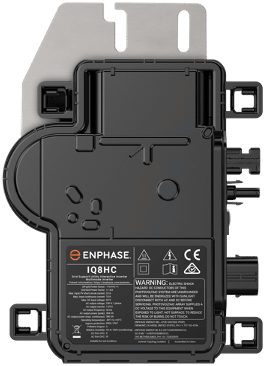
As mentioned in the introduction, microinverters transform the electricity harvested by the solar panels (DC) into the type of electricity that can be used in your home (AC). Why does it need to do this?
Solar panels are only capable of outputting DC electricity.
All the electricity in your home is AC electricity.
The conversion is necessary to make that power usable.
The other type of solar inverter technology is a string or central inverter located on the side of the home. A microinverter converts power at each panel, so you have multiple microinverters for each solar system as opposed to one central inverter.
It’s a decentralised system.
If you’re interested in learning a bit more about the inner workings of a microinverter solar systems, you might want to check out the following article titled, How Do Microinverter Systems Work?
What Are the Advantages of Solar Microinverters?
There are a lot of advantages to engineering a decentralised solar system featuring microinverters. Each microinverter is mounted beneath each solar panel to convert the electricity from DC to AC immediately before sending it down to the home.
Independent Operation: Because each solar panel has its own microinverter, the power that each panel produces can be outputted to the home directly. In a string inverter system, the panels work a little like Christmas lights and much like a string of Christmas lights, when one goes out the entire system shuts off.
When one solar panel in the string of panels drops in efficiency or stops working, all the solar panels drop to match the weakest link.
This isn’t the case with microinverters. In a microinverter solar system, each panel works on its own with its own microinverter. There is no central point of failure.
This is the biggest advantage of microinverters. The efficiency of the overall system is divided, not centralised.
Here’s Another Example: Think of a solar system like the motorway.
- Microinverter System: A microinverter system has four lanes of traffic, and each lane has a car of its own. The flow of traffic is decentralised across four lanes. In this metaphor, a
- String/Central Inverter System: It has four cars right behind each other in one lane. If anything happens to the speed of the first car, the other three slow down to match it.
It’s an issue of efficiency.
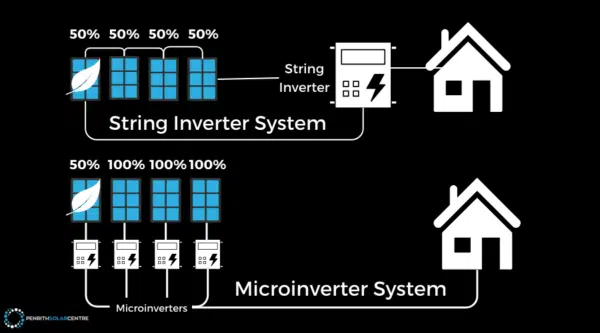
Shading: Solar panels can only produce electricity if they’re receiving direct sunlight. Their efficiency is dictated by this fact of science. When your solar panels are partially or completely obscured by the shade of a big, beautiful tree, they will not harvest energy for your home.
Microinverters excel in scenarios with shading because each panel operates independently. Shading on one panel does not affect the performance of the panel next to it if it’s receiving direct sunlight. Each panel is able to output to its maximum power. They are extremely efficient.
A string inverter system will suffer from shading. The panels do not operate independently. When one is shaded or partially shaded, the entire string reduces its performance. The entire system can only perform as well as the poorest performing panel.
Panel Orientation: No two roofs in the Sydney metro area are the same. Of course, there are exceptions to this, like the occasional housing development. For the most part, each solar system will have a unique design once your installer factors in roof real estate and your household’s energy use and needs.
Solar systems with microinverters can be flexible in their design because each panel is operating independently of the others.
Panels facing different directions perform more efficiently:
- Panels facing east generate power in the morning.
- West-facing panels generate power in the afternoon.
- Combining them offers a more even distribution of energy throughout the day.
For more information on energy consumption patterns and how they impact the design of your solar system, you might want to check out this article titled Which Way Should Solar Panels Face in Australia?
Enhanced Safety: The direct conversion of energy from DC to AC at each panel reduces safety risks associated with high-voltage DC systems. DC electricity behaves differently from AC electricity.
- DC power moves in an unrelenting straight line of consistent power.
- AC power alternates 50 times a second in a sinusoidal waveform.

The science and engineering that explains how DC power is more dangerous in solar systems than AC power is complicated. It basically comes down to how easy it is to shut the system down.
- AC Systems (microinverters): Because a microinverter system converts the electricity from DC to AC at the panel level and then sends it down to the main switchboard, it can be completely shut down in the event of an emergency.
- DC Systems (strings inverters): A string inverter system, which has a central inverter on the side of the house, keeps that electricity in its more volatile state as it journeys through the wires to the main switchboard.
Regardless of the type of system you put up on your roof, having a good installer who knows their business is the biggest safety feature for your home. The risk is only an issue in the case of an emergency where the wire is compromised.
Reliability: Microinverters have a projected lifespan of 30 years. Warranties can vary from 15 to 25 years depending on where you live.
In Australia, the IQ8 comes with a 15 year warranty but it can be extended to 25 years for a little under $20 per microinverter. In the United States the same microinverter comes with a 25 year warranty. This has to do with consumer protections in Australia.
Real-time Monitoring: Microinverter systems often come with monitoring tools that let you track each panel’s performance. It’s an app on your smartphone or a website on your internet browser.
This information is extremely helpful when it comes to making choices around your energy needs and goals. If you know when you use power generated by the solar panels versus when you use power from the electrical grid, you’ll be able to make choices to save money and energy.
Monitoring the performance of individual panels with microinverters makes it so much easier for technicians to diagnose problems with the solar system. We have a full time service department that can link up with your Enphase Enlighten App and figure out instantly which microinverter is malfunctioning.
It’s much easier for our team to arrive on-site, quickly fix any issues, and get your solar system up and running at optimal efficiency again. We rock up with ladders at every site with the expectation that our crew will be up on the roof. Replacing them is a snap for us.
Expansion/Future Proofing: Expanding your solar system down the road, sometimes called “future proofing,” is becoming a real concern for many customers who are shopping for solar.
It’s a good idea to build the system that best fits your needs at the time you invest in a system. These decisions should be made based on the energy consumption patterns of your household at the time you install your system.
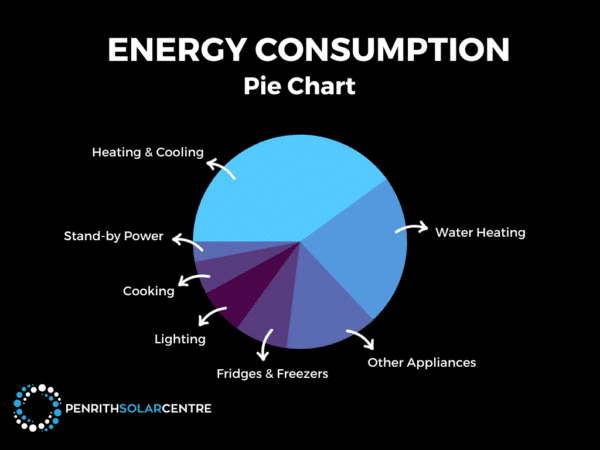
However, energy needs can change. The current energy crisis might dictate the need to expand your solar system in the future. You might want to add a battery to your solar system, or you might purchase an electronic vehicle that will require a charger in your garage. You may need to add an additional row of panels on the roof. You can’t do that with strings.
Adding more panels to your system in the future is straightforward with microinverters. When each panel operates independently, it’s easy to add a new bank of panels. You simply install them on the roof and plug them into the existing system.
With string inverters, you’ll need to add additional components. They’re very challenging to upgrade once installed. We’ll get into this in more detail shortly.
What Are the Disadvantages of Solar Microinverters?
Higher Upfront Cost: Microinverter systems are more expensive upfront. Full stop.
This is the biggest drawback of this type of solar system. It can range from 20 – 30% higher in some cases than string inverter systems.
Because each solar panel has its own microinverter, the cost of this technology raises the upfront price of the whole system. It’s simply more parts contributing to the whole.
However, it’s important to note that when you are calculating the cost of a solar system, the upfront cost needs to be weighed against the amount of money you’ll be saving on your electricity bills. The solar system you choose will pay for itself in time based on how much you’ll save on electricity by generating it yourself.
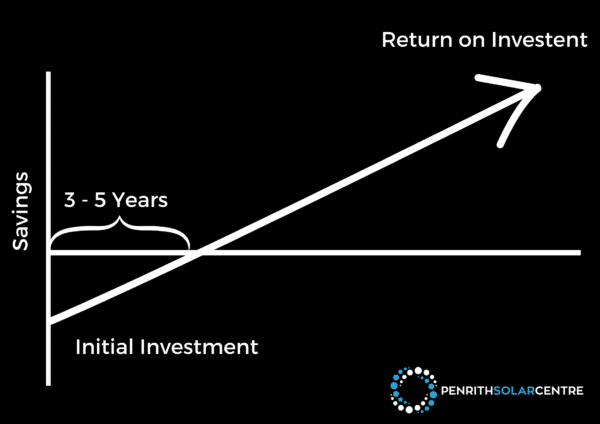
A microinverter system may cost more to install, but it’s more efficient than a string inverter solar system. The better it can harvest and transform that electricity to your home, the more money you will save over time.
- String systems costs less upfront, but costs more long term.
- Microinverter systems costs more upfront, but costs less long term.
Manufacturer Dependence: The solar industry is evolving very rapidly. There’s absolutely no way to predict what the needs of your home, community, or ecosystem will be as we adapt to the current climate crisis.
Changing your system in the future might be limited depending on how solar technology evolves. Maybe some new piece of technology could be invented that clips onto your solar panels and doubles their efficiency. Or something else along those lines. An imaginary invention like that, hypothetically speaking, might not be compatible with Enphase microinverters. It’s unlikely, but it is possible because no one knows what the future holds.
For more detailed information on the cost of microinverter solar systems, you might want to read the following article: How Much Does a Microinverter Solar System Cost?
What Are Solar String Inverters?
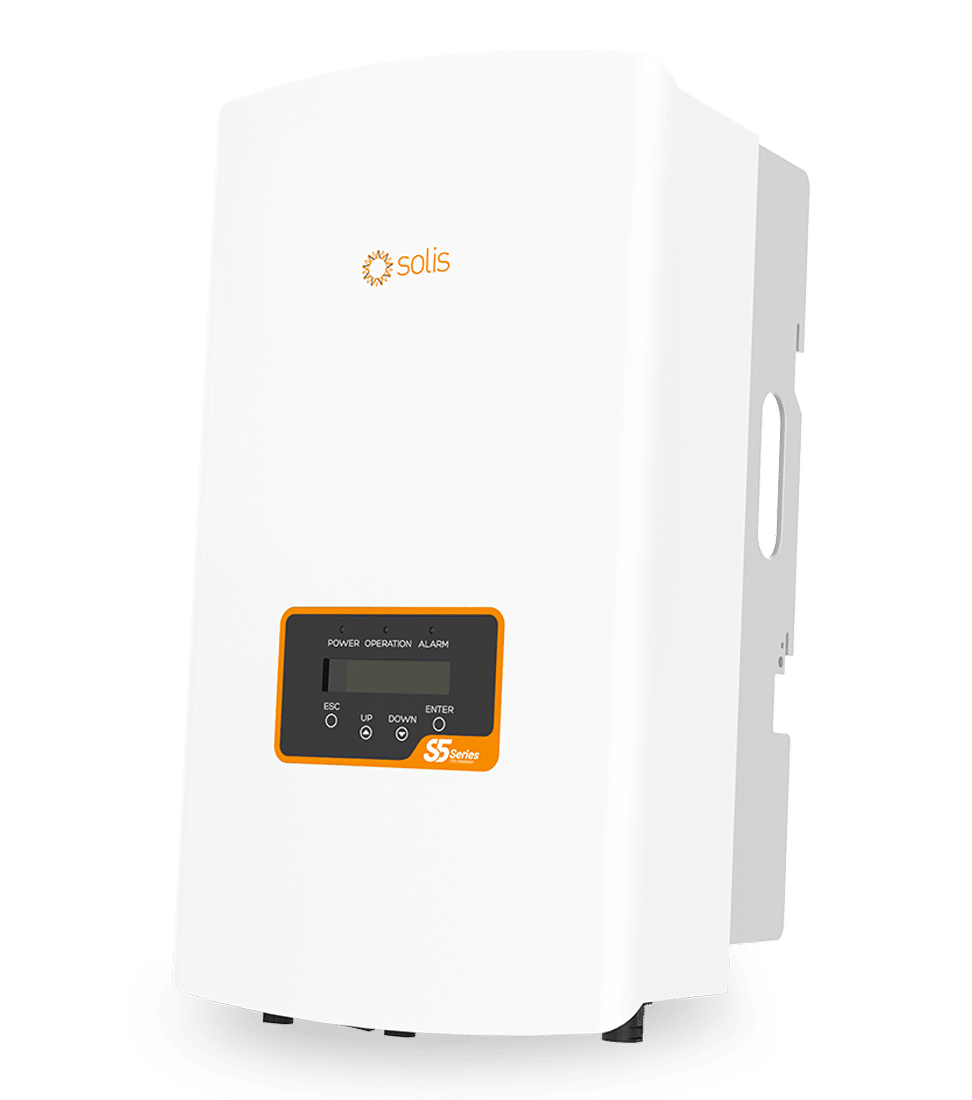
String inverters (also known as “central inverters”) are another type of inverter used in solar systems. Unlike microinverters, string inverters are centralised devices that convert the DC power from a group of panels (a “string”) into AC power.
String inverters do the exact same thing that microinverters do, but they do it at a different location. They’re often installed on the side of the house near the main switchboard. It’s one piece of technology that does the converting instead of independent components mounted beneath the solar panels (microinverters).
What Are the Advantages of Solar String Inverters?
Cost: String inverter solar systems are cheaper. The upfront cost is lower and there’s the potential, as mentioned above, for them to pay themselves off rapidly; quicker than a microinverter solar system.
A string inverter system that outputs 6kW of power will cost less per kilowatt than a microinverter system that outputs the same amount of power. This is especially true for larger installations with customers who have larger energy needs.
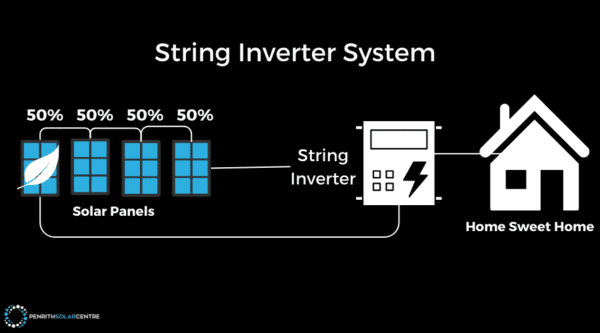
Installation: String inverters are a well-established technology with lots of companies offering availability, installation, and upkeep. Just about anyone working in solar can install them because string inverters have been around since the beginning of solar. Many electricians know how to install them.
Compatibility: The different components of string inverter systems work with various solar panel brands and models if they match the inverter’s specifications. They are widely compatible pieces of technology.
It’s possible to mix and match equipment to reach a lower price point. Different parts can be easily replaced. Not only because of their compatibility with existing technology but also because most installers can handle the job.
Embrace solar, embrace savings
What Are the Disadvantages of Solar String Inverters?
Central Point of Failure: As mentioned previously, string inverter solar systems work like Christmas lights: when one panel stops working, the entire system is affected.
Because of this happening, diagnosing the system and repairing it is costly. It takes so much time to find the point in the string where it failed.
There is the cost of the repair work that needs to be done but there is also the cost of the solar energy lost while the system is offline. In some cases, your home might be without solar for up to a month, losing out on the benefits of free electricity.
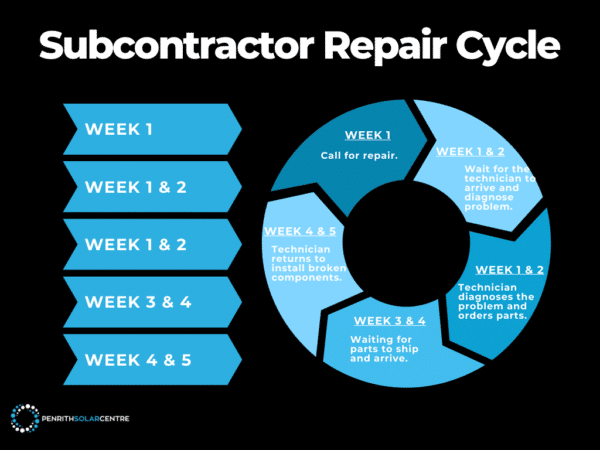
Shading: Shading on a single panel can affect the entire string’s performance. The weakest panel’s performance affects all of them. We mentioned this previously when using the metaphor of driving on the motorway. The slowest panel forces all the other panels to drop to its level of efficiency.
When one panel is shaded or partially shaded, the entire string underperforms. Real-time monitoring doesn’t exist for string inverter systems the way it does for microinverters. There’s just no way to see which panels are underperforming the way you can with a microinverter system monitoring app because the efficiency of a string inverter system is measured by the entire string’s performance.
Here’s this graphic again so you don’t have to scroll up:

This makes it difficult to optimise your solar system and repair it when it’s underperforming.
Safety: String inverters don’t convert the DC power to AC power at the panel as microinverters do. High-voltage DC current instead travels across your roof down to the house, increasing the risk of an electrical fire.
Of course, a good installer who understands the ins and outs of string inverter systems will know how to install this type of system as safely possible.
Noisy: Fans keep a string inverter solar system cool and make a fair amount of noise. In the summer, you won’t be able to ignore the drone of those fans.
Important Considerations to Remember
Solar power is a great way to help the environment and cut down your energy bill. Often, it’s a significant investment so choosing the right equipment for your system is important.
Before deciding between microinverters and string inverters, consider the following:
Budget: Microinverters cost more upfront, and string inverters cost less upfront. Over time, the cost reverses as strings cost more in terms of efficiency over time and micros make more money long term. If you don’t mind some of the safety risks involved with string inverters, it could be the way to go.
Roof Design: Microinverters handle shading and different panel directions more efficiently. String inverters work well when the panel orientations are simple. If your installation is relatively simple, a string inverter system might be better for you.
Property Lifecycle: Microinverters offer flexibility for expansion and have a longer lifespan. String inverters are shorter-term investments for less money. Future modifications are an important consideration. String inverters are difficult to upgrade, and the cost will be significant if you want to do that. Microinverter systems can easily add additional panels to an existing array.
Compatibility: Microinverters rely on manufacturer support and advancements. String inverters are serviced by almost anyone. Which might make a difference in secluded or remote regions where servicing your solar system could be challenging.
Microinverters Won’t String You Along
We hope you feel a little more informed about microinverters and string inverters. It’s an important decision to make when choosing your solar system. The more you know about these pieces of technology, the better decisions you’ll make around your solar investment.
Choosing between microinverters and string inverters comes down to your specific needs and circumstances. By considering factors like cost, shading, and system size, you can make a decision that aligns with your goals.
Picking a trustworthy installer for your solar system is an important part of the decision process. Penrith Solar Centre is here to help you find the best fit for your home, and that starts with helping you get informed about this decision. We want you to be an informed shopper and we want you to make the best decision for your unique energy needs.
The goal is to reach Net Zero by 2050. For all of us.
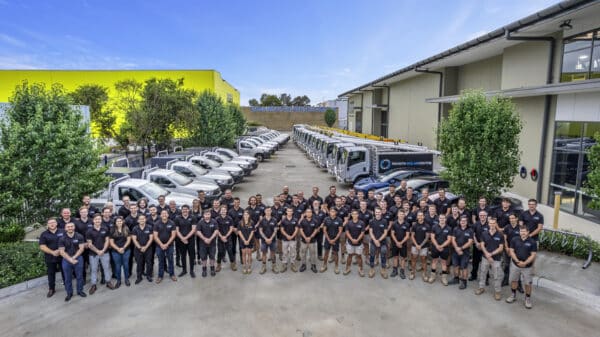
For more information on microinverters, we recommend you read this article titled What Are the Benefits of a Microinverter System?

